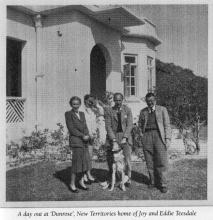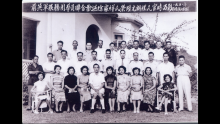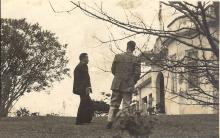Current condition
Demolished / No longer exists
I'm trying to rediscover all I could about 'Dunrose' at Castle Peak opposite the Gold Coast Resort Hotel. It was a colonial bungalow serving as the residence of the District Officer Yuen Long (DO-YL). I believe it is still standing there today, obscured behind big trees. British Officers from the adjacent garrison camps used to attend mass there on Sundays, and had tea in the garden after mass. Paul Tsui was DO-YL 1950-52 before he left for London for his HMOCS Devonshire Course II at Oxford & LSE. The place contains my first recollection of childhood.



Comments
Possible location of Dunrose
Hi Lawrence, based on your note that Dunrose was "flanked by Army Barracks 1950-52.", I wonder if Dunrose was where Palm Beach is today? Looking at the 1952 map, that site was flanked by the Gordon and Tai Lam camps:
https://gwulo.com/node/10531?a=1#16/22.3752/113.9898/Map_by_ESRI-1952_A…
The map shows there were also buildings nearby, but just south of Castle Peak Road. They could be another possibility for Dunrose's location.
Regards, David
Dunrose
I was rather small at the time. However, I do remember being taken across the road to the house of Mr. Tsang Yung, owner of the black & orange colour Blue Taxi in Kolwoon, for swimming in his pool. We also used to have a painting at home of Cafiteria Bay drawn by Architect Szeto Wai. He must have drawn that so that we could remember the nearby view after we moved to Belcher Gardens, Pokfulam Rd. Dunrose was definitely on the slope side and not beach side since we, as kids, could walk up the hill from time to time from our backyard (that was long before the Tuen Mun Highway was built right above).
I noticed Dunrose was there still until a decade or two ago, except the trees in front had grown much bigger. Hearsay it was used as office for an NGO.
Lawrence
Dunrose Castle Peak
I think the site suggested by David for Dunrose is incorrect. I walked along that length of CP road many hundreds of times in1959/60 and have no recollection of any building on the inland side of the road. A large mountain spur separated the west end of Tai Lam camp from Gordon Camp a distance of about half mile. Our Officers Mess was on rising ground at the east end of Gordon Camp and was an older style colonial bungalow with verandas very reminiscent of the photos. The mess had its own independent driveway up from CP road. From the bottom of the drive you crossed straight over to the access road to what is now New Cafeteria Beach. I would speculate that our mess building may formerly have been Dunrose.
Dunrose search
There is an 'Old Tuen Mun' Facebook page that is or was seachable by area of the town
https://en-gb.facebook.com/pg/tuenmunoldphotos/photos/?ref=page_internal
It was accessible and useful as it had many images from the 1940s onwards, but entry to it appears to have been changed for non Facebook members.
3D Google Earth
Could it have been near Mun Fat Lane?
This 3d render from Google Earth shows a cluster of buildings but there are a couple of empty terraces at the top that look to have had structrues on them at some point? This area is opposite New Cafeteria Beach.
Dunrose Castle Peak
I think Philk is correct. Looking at the two buildings on the left in the clump of trees, I would guess that area was the site of our Mess / Dunrose? If you look to the north of the 2 buildings you will an indistinct patch of open ground. This would accord precisely with location of one of the mess accommodation blocks, a so called "Hong Kong hut".
Dunrose- military site opposite Gordon Hard
The military site opposite Cafeteria Beach and Gordon Hard in the early 1980s can be seen here when it was still military land
https://gwulo.com/atom/26415/zoom
Zoom in and scroll the image to the left end of the image and then zoom in selectively
The military site can be clearly seen, including military vehicles and a couple of vintage buildings
Dunrose / Mess
I've found a mention of Dunrose c.1963/4:
We were fortunate because Dunrose, the District Officer’s house, had its own supply of water from a stream far up in the hills. This dried to a trickle in the great drought, but did not dry up completely. We suddenly became very popular with our friends from town who enjoyed coming out for the uninhibited pleasure of a shower and to fill their cans to take back to town.
From page 40 of Feeling the Stones: Reminiscences by David Akers-Jones
That confirms I'd put the marker at the wrong location, as there aren't any streams there. There are a couple of streams by the old Gordon Camp, so I've moved the marker there.
The Officers' Mess was also in operation in 1963/4, which would make them different buildings. There's a building still standing called 'Watervale', which says it was used as the Officers' Mess. I've made a page for it at https://gwulo.com/node/36912
Dunrose
An extract from Jason Wordie's 2007 book "Streets - Exploring Kowloon" (p203): "One of the more impressive viewpoints towards Lantau and the airport bridges is located at Ting Kau. This was built on the site of the former official residence of the District Officer South, known as 'Dunrose'. According to one former occupant, the house was originally built by a retired China missionary couple named Duncan and his wife Rose; the building's name was an amalgam of the two. 'Dunrose' has long since been demolished, and the name largely forgotten."
Unfortunately a precise location for 'Dunrose' is not given in the book (other than 'Ting Kau'), but it's interesting to know what might have been the story behind the name.
Dunrose
Hi Liz
Ting Kau is a long way from where we were originally looking so I am not so sure about the information in that book. Ting Kau is at Milestone #11 and the spot we have been looking it is just past Milestone #18.
Phil
Edit: of course, keeping an open mind, perhaps we are looking in the wrong place...
Location of Dunrose
Aha, thanks Phil. Quite a big difference between the two, then!
Chapter 17 of Brian Wilson's
Chapter 17 of Brian Wilson's book Hong Kong Then has a description of Dunrose:
The District Officer's quarters at 'Dunrose' on the Castle Peak Road consisted of a pre-War bungalow and garden lying a short distance from the road. The house had its own water supply coming from a year-round stream that ran down the steep hillside behind the house and continued to the sea a few hundred yards away.
[...]
On the opposite side of the Castle Peak Road to 'Dumose' stood a large two-storey house occupied by an elderly Chinese couple. He was the retired owner of the Blue Taxi fleet, which in those days enjoyed almost a monopoly of the taxi business in HK. He liked to potter about his garden looking like one of his gardeners, wearing a singlet, long baggy shorts and thongs. A stranger might tell them apart only by his gold watch and gold-rimmed spectacles. He kindly invited us from time to time to use his swimming pool, which had a changmg room with an English notice saying 'Do not urinate in the pool'. His wife would always lead us through her Western-style drawing room with furniture and carpets from Harrods in London, still covered in polythene and apparently seldom used. She and her husband preferred a separate Chinese-style room. In a first-floor room, he invited me to look through his powerful telescope, which was focused on Macao, some forty or fifty miles away across the mouth of the Pearl River.
[...]
This shouldn't be hard!
Dunrose was the home of David Akers-Jones and Rachel Cartland, amongst others, both of whom are still alive and kicking in Hong Kong. It really shouldn't be hard to ask them where exactly it was!
p132 of Rachel's book, Paper Tigress, describes the address as 18½ Miles Castle Peak Road, and "next door to Perowne Barracks"; it gives quite a lot more background on the property.
Dunrose
Are you sure about David Akers-Jones? The two HK Standard reports linked from his wiki page mention that his place was in Sham Tseng - still a fair few miles from MS18 (closer to MS13/12 I think). If it was the same place then it was demolished to make way for the road widening in the early 2000s.
Two SCMP articles mention the Akers-Jones' house as being between Sham Tseng and Ka Loon Tseng. I can't find a Ka Loon Tseng on the map but I can find a Ka Loon Tsuen at MS15. So I don't think this is the same house.
http://www.scmp.com/article/205426/akers-jones-uproots-plan-move-rare-p…
http://www.scmp.com/article/199767/home-demolition-hit-akers-jones-rare…;
Edit: I've just realised you are talking about when he was serving in Colonial Administration rather than when he was retired, so scratch the above comments.
District Officer, Yuen Long
Yes indeed. It was the home of the District Officer of Yuen Long, which was the role of Mr Akers-Jones and later (in the mid-late 1970s) of Michael Cartland (Rachel's husband). I have passed a message about this page to Mrs Cartland via Pete Spurrier, her publisher, and I hope that she may drop by to enlighten us.
Dunrose
I lived in Dunrose 1976-79 because my husband Michael was District Officer Yuen Long. It figures largely in Chapter Six of my memoir Paper Tigress (pub. Blacksmith Books). There are photographs too.
As far as I can, I'll comment on the various issues that have been raised.
I infer that Lawrence Tsui is the son of Paul Tsui. I only met Paul a few times but he was famous within the Administrative Grade: for his war record, his status as the first local Chinese cadet and his impressive personal qualities, his integrity and so on.
Dunrose is no longer standing. I believe that the Palm Beach residential development is on the site but all signs of Dunrose have been obliterated, including its driveway and garden. It was immediately adjacent to Perowne Barracks, base of the Gurkha Engineers when we were in residence. It was on the upper side of Castle Peak Road, not the beach side (Cafeteria Beach). There was a large house on the opposite side of the road which at that time was the property of Henry Fok Ying Tung though I wonder whether it had previously belonged to Tsang Yung, as described in these reminisences.
I know that at some point after Dunrose was no longer being used as the District Officer's residence it was temporarily allocated to the St. Stephen's Society, a charity helping drug addicts that had its roots in the Walled City.
For once, Jason Wordie has got things a bit wrong. Dunrose was definitely not in Ting Kau. He may have been thinking of Homi Villa, the official residence of District Officer Tsuen Wan which was in Ting Kau and became a lookout point/display area for the infrastructure projects (Tsing Ma Bridge etc.). I believe it may still fulfil that function.
David Akers-Jones did indeed live in Dunrose when he was District Officer Yuen Long. After he retired from the Government he and his wife lived for a while at a self owned property in Tsing Lung Tau, Sham Tseng.
Dunrose
Many thanks to Rachel for giving us a fairly definitive answer and to Paul for putting out the word. For future reference, Rachel's book is published by Pete Spurrier's Blacksmith Books and can be bought here: https://www.blacksmithbooks.com/books/paper-tigress-a-life-in-the-hong-…
It's good to have this fixed
It's good to have this fixed at last. I've updated the marker to the correct location.
Dunrose
I was born in 1955 when my parents lived in Dunrose. My father Brian Wilson was the district Officer. I dont remember it at all!
Dunrose
This is all very exciting. I lived in Dunrose as a child. My father, Patrick Williamson. was the District Officer for Yuen Long. I think it was between 1970 to 1974 It was a lovely bungalow with the most beautiful garden. It had a huge flame of the forest tree in it. I agree-it was not on the beach side but the other side of the road. The sailing club was on the other side. My father is still alive and mentioned Dunrose last night. I see if I can find photos.
It definitely was 18 and a half milestone.
Dunrose was my childhood house. My father was a district officer.
DUNROSE AND MRS. WILLIAMSON
Hello,
You remind me of our ex-pat English teacher Mrs. Williamson working at a new secondary school back in 73 in Tuen Mun.Mind me asking if she is your mum. Name of the school is St. Simon's Lui Ming Choi Secondary Technical School. The school is still there sitting next to West Rail Terminal. She only taught for a few months .
Like to hear from you.
Dunrose and Paula Williamson
Yes that would have been my mum! I can’t remember her teaching there but she did teach maths at a few secondary schools in Hong Kong.
How lovely that you remember her!
Sam
Hi again
Hi again
I just spoke to my Dad. My mum definitely worked at that school. Well remembered!
Sam,
Sam,
Nice to hear your feedbacks. It’s really amazing how internet brings us back all those sweet memories . What a pity I didn't have any photo of your mum since a camera those days meant a private jet nowadays. I also remember another ex-pat teacher Mrs. Davids whose husband served the British Service that time .Probably you met her in one of your family gatherings in Dunrose. She taught us that poem “Faster than fairies, faster than witches, Bridges and houses, hedges and ditches…….”
Time is really flying.
Chris
Re: Naming of Dunrose
The first mention of Dunrose is from the 1934 Jurors List.
Duncan Tollan, a senior engineer with the Hong Kong Telephone Co. resided there with his first wife, Rosina (aka Rose) Wilson Cray Tollan. They had five daughters, one daughter was also called Rose who died on 3 December 1919. Rose Tollan (1905-1919) is buried in the Hong Kong Cemetery. See here